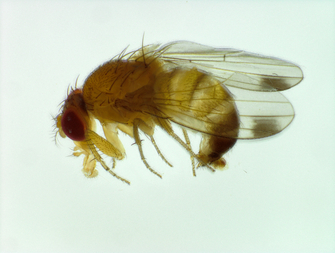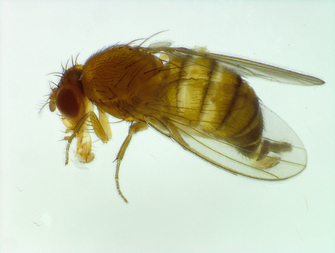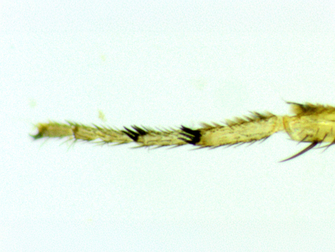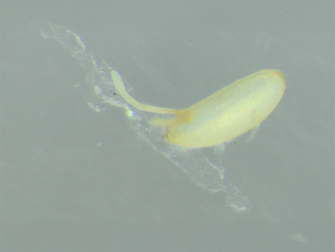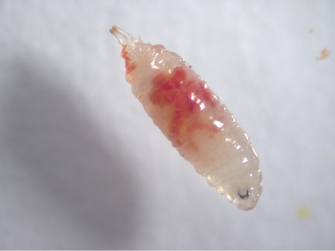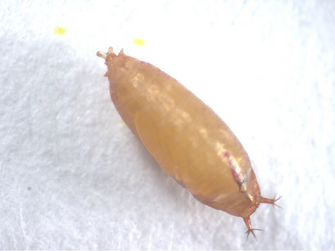Spotted wing drosophila
Drosophila suzukii
Appearance
The cherry vinegar fly belongs to the family of vinegar and fruit flies (Drosophilidae) and is erroneously referred to as a fruit fly. The adult flies are approx. 2 - 3 mm in size, light brown in colour, have red eyes and feathered antennae. The males have a conspicuous black spot on the transparent wings, which is not yet clearly visible in animals that are not yet fully hardened, and two bristle crests on the forelegs. The females have a characteristic strongly toothed ovipositor.
The larvae are white, legless fly maggots with black mouth hooks.
Biology
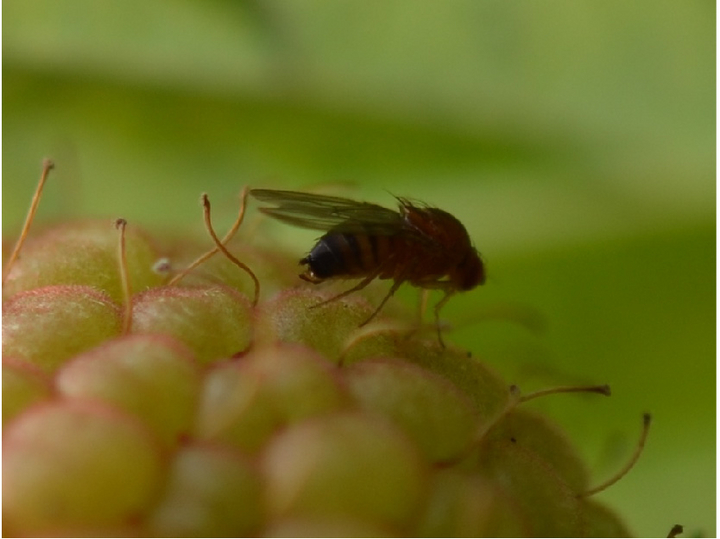
Unlike the other representatives of the vinegar flies, the cherry vinegar fly does not seek out fermenting, rotting fruit, but prefers to attack healthy, ripening fruit. The females can score the fruit with their toothed ovipositor and lay the eggs inside the fruit, where the fly larvae (maggots) then feed on the pulp. Pupation occurs in the fruit or in the soil.
Under optimal conditions (temperature around + 25 °C), development from egg to adult fly can be completed in about eight days, producing up to 15 generations per year; at cooler temperatures, development takes correspondingly longer. The adult fly hibernates in protected places, at temperatures above + 10 °C it can also remain active.
In Austria, five to seven generations per year can probably be expected based on the present temperatures.
Long-term observations showed that adult cherry vinegar flies occur throughout the year. In winter until early summer only a few flies occur, from summer on (mostly from July on) the number of individuals increases significantly and in autumn (September/October) the peak is reached. The rate of reproduction or increase in individuals depends mainly on climatic conditions, but also on the availability of host plants. Humid, warm conditions and the presence of appropriate host plants can lead to strong emergence up to mass reproduction within a very short time. On the other hand, dry and hot weather (temperatures above + 30 °C) has an unfavorable effect on their development and a lower number of individuals is the result.
Damage symptoms
Cherry vinegar flies infest ripening, soft-skinned fruit. Infested fruits show small hole and sting-like damage and depressed soft spots on the surface.
Larvae are found within the fruit, feeding on the flesh.
In addition, secondary infections may occur due to fungi or bacteria. The damage is recognizable by rotting fruit.
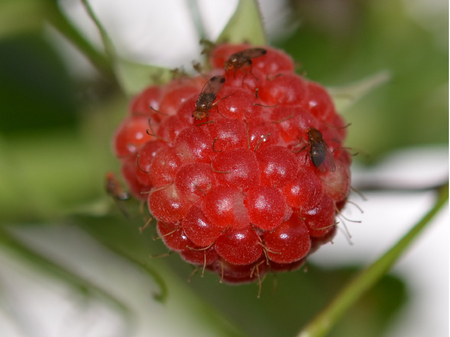
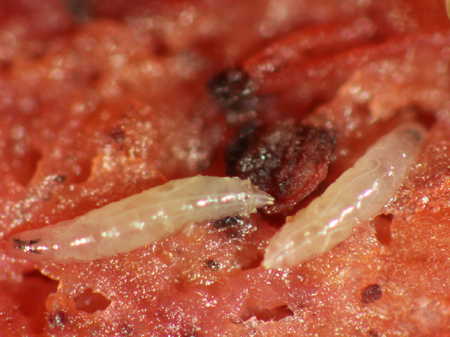
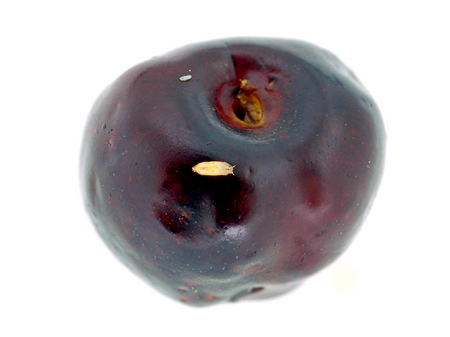
Host plants
The cherry vinegar fly can use a wide variety of host plants. It attacks all soft-skinned wild and cultivated fruits, preferring sweet cherries, but also peaches, nectarines, apricots and plums(Prunus spp.), blueberries (Vaccinium spp.), raspberries and blackberries(Rubus spp.), currants and gooseberries (Ribes spp.), and strawberries(Fragaria ananassa).
Other possible host plants include hardy kiwifruit(Actinidia sp.), elderberry(Sambucus sp.), mulberries(Morus sp.), dogwood(Cornus spp.), persimmons (Diospyros kaki), figs (Ficus carica), table and wine grapes(Vitis vinifera), tomatoes (Solanum lycopersicum), and melons (Curcubitaceae).
In addition, already damaged fruits, such as apples (Malus domestica) and nashi pears(Pyrus pyrifolia) can be attacked by cherry vinegar flies.
Distribution
The original home of the cherry vinegar fly is the Asian region. It was not until around 2008/2009 that it was found to occur in North America (east and west coasts) and Canada, as well as in Europe (Spain, France, Corsica, Italy, Slovenia), and in 2011 also in Switzerland, Austria and Germany. Since then, a very rapid spread occurred in Europe, North America and also in the south of South America.
Economic importance
Since the population peak of cherry vinegar flies is in late summer and fall, there is an increased risk especially for later crops.
The cherry vinegar fly can cause up to 80% yield loss and even total failure on affected crops.
Also worth mentioning are the high additional costs for the corresponding countermeasures with the associated personnel expenditure required for sufficient crop protection.
Prevention and control
The basic rule for cherry vinegar fly control is that only a combination of all available measures can lead to success and thus avoid or at least reduce major damage.
Preventive measures:
- Hygiene measures:
- regular removal of ripe and overripe fruit from the orchard or fruit plantation
- complete harvesting, including fruit that is not marketed, or thorough removal of residual fruit after harvest (post-harvest measures)
- pay attention to low grass stand (greening)
- no composting of the fruits, because here a survival of the flies is possible
- Killing of eggs and larvae in the remaining fruit, for example by means of solarization (fruit is packed airtight, e.g. by means of foil covering, and exposed to intensive solar radiation) or by means of low temperatures (e.g. freezer).
- Keeping the cold chain, cold storage of fruits (immediately after harvest)
- Monitoring to determine the presence of cherry vinegar flies or cherry vinegar fly infestations:
- of oviposition on fruits: visual inspection (with magnifying glass/microscope) of fruits for eggs or respiratory filaments protruding from fruits.
- of larvae in fruits: Opening of fruits and visual inspection (with magnifying glass/microscope) or by water or salt water method. Fruit is placed either in water (for two hours) or in a 10% saltwater solution (for one hour) and checked for emigration of potentially present larvae.
- Of adult cherry vinegar flies: with traps and attractant liquid.
- There are a variety of traps and trap/lock fluids that can be used - each with advantages and disadvantages. These are either commercially available or can be homemade. However, the following criteria should be met to achieve good trapping results:
- The trap consists of a vessel (e.g. cup, bottle) with many, small openings (Ø = approx. 2 mm) (not larger because of bycatch!)
- Use of a suitable trapping liquid, e.g. apple cider vinegar - the addition of red wine and/or yeast increases the effect
- Positioning of the traps in the shade
- Monitoring to detect the occurrence of cherry vinegar flies or cherry vinegar fly infestation:
- of egg laying on fruit: visual inspection (with magnifying glass/microscope) of fruit for eggs or respiratory threads protruding from fruit.
- of larvae in fruit: Opening of fruits and visual inspection (with magnifying glass/microscope) or with water or salt water method. The fruits are either placed in water (for two hours) or in a 10% salt water solution (for one hour) and checked for the migration of potentially present larvae.
- of adult cherry vinegar flies: with traps and luring liquid
- There are a variety of traps and trapping/attracting liquids that can be used - each with advantages and disadvantages. These are either commercially available or can be made yourself. However, the following criteria should be met in order to achieve good trapping results:
- The trap consists of a container (e.g. cup, bottle) with many, small openings (Ø = approx. 2 mm) (not larger due to bycatch!)
- Use a suitable trapping liquid, e.g. apple cider vinegar - the addition of red wine and/or yeast increases the effect
- Position the traps in the shade
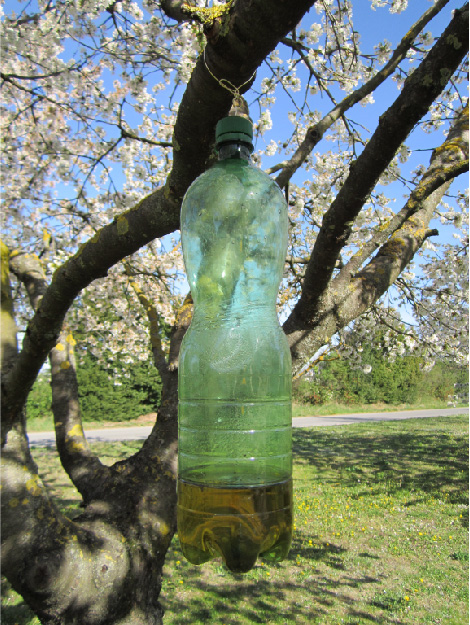
The number and arrangement of traps depends on the intended use. In cherry vinegar fly monitoring in Austria, two traps were used per site.
Targeted measures:
- Netting of plants or crops: a very effective measure against cherry vinegar fly damage is the protection of crops by means of nets. There are various possibilities to net only parts of plants, single crops (e.g. trees) or the whole plant, e.g. lateral netting, partial netting or full netting. However, it is important to ensure timely, complete netting without gaps, using fine mesh nets with a mesh size of 0.8 mm to 1.0 (-1.2) mm to deter cherry vinegar flies. Further information can be found in the Julius Kühn Institute project "Demonstrationsvorhaben: Netting of fruit crops for protection against cherry vinegar fly".
- Mass trapping with traps: in mass trapping, the traps are deployed before the cherry vinegar flies appear or before the fruit begins to ripen in order to intercept the migrating flies. It is recommended to place the traps at a distance of 2 m around the plant, additionally there is one more trap in the middle of the plant as a control.
- Chemical control: with plant protection products approved in Austria - see also emergency approvals, which may be available each year for specific crops and limited time period.
Research
More effective solutions to control cherry vinegar fly are still being worked on. Thus, the use of natural antagonists (e.g. parasitic ichneumon flies) is a major goal, but also the use of more efficient and specific trapping fluids, repellents, rock meals, ... and many other possibilities.
Specialized information
Publications
Lethmayer, C. (2012): Current situation in Austria: still only single findings of the cherry vinegar fly. - Better Fruit 10-11, 4-5.
Simoni, S., Baufeld P., Northing P., Bell, H., Gargani, E., Cuthbertson, A., Lethmayer, C., Egartner, A., Bluemel, S., Kehrli, P., Anfora, G., Grassi, A., Baroffio, C., Masci, A., Linder, C. & Ioriatti, C. (2013): DROSKII: a transnational attempt for insight on the damage potential of Drosophila suzukii and on the development of risk management and control measures. - IOBC-WPRS Bulletin 91, 323-326.
Lethmayer, C. & Egartner, A. (2014): The cherry vinegar fly also discovers Austria for itself - Better Fruit 4, 4-6.
Lethmayer, C., Egartner, A. & Blümel, S. (2015): Evaluation of different trap types for catching the spotted wing drosophila (Drosophila suzukii). - IOBC-WPRS Bulletin Vol. 109, 187-193.
Lethmayer, C. & Egartner, A. (2015): Explosive reproduction of cherry vinegar flies. - Better Fruit 1, 6-7.
Lethmayer, C. & Egartner, A. (2016): Cherry vinegar fly: which trap is best? - Better Fruit 2, 14-16.
Lethmayer, C. & Egartner, A. (2017): Enhancement of Drosophila suzukii trapping. - IOBC-WPRS Bulletin Vol. 123, 143-149.
Lethmayer, C. & Egartner, A. (2017): Cherry vinegar fly is unfortunately no longer a regional problem. - Better Fruit 3, 16-18.
Lethmayer, C., Wernicke, M. & Blümel, S. (2019): Laboratory choice trials to identify repellent substances against Drosophila suzukii. - IOBC-WPRS Bulletin Vol. 144, 8-15.
Wernicke, M., Lethmayer, C. & Blümel, S. (2020): Laboratory trials to investigate potential repellent/oviposition deterrent effects of selected substances on Drosophila suzukii adults. - Bulletin of Insectology 73 (2), 249-255.
Our monitoring activities
In Austria, the first reports of an occurrence of the cherry vinegar fly were received in 2011. Therefore, starting in 2012, a nationwide monitoring with attractant traps was conducted at selected sites in orchards and vineyards. This was carried out under our management, in cooperation with and with the support of employees of the Chambers of Agriculture and the official plant protection services of the federal states, Natur im Garten, Weinbauschule Krems and HBLA Klosterneuburg.
In addition to trap monitoring, visual monitoring for deposited eggs of the cherry vinegar fly on grapes has also been carried out in selected vineyards since 2016. These data, which were collected regularly until harvest, served as information for the warning service in viticulture, which can be found at the Vine Protection Service under insect-watch.
Since the number of cherry vinegar flies caught in traps only allows limited conclusions to be drawn about the actual number of flies present and thus about the risk of infestation, trap monitoring has only been carried out at a few sites since 2020. From 2021, there will only be monitoring or control for eggs on grapes in the vineyard for the warning service, which gives a much better indication of the respective infestation situation in the investigated area/vineyard.
Projects
EU-ERANET EUPHRESCO-II-Project DROSKII: "Damage potential of Drosophila suzukii and development of risk management and control measures"; 01.06.2012 - 30.05.2014
EU-ERANET EUPHRESCO-II project IPMDROS: "IPM Strategies against Drosophila suzukii", 01.07.2014 - 31.12.2016
Interreg V program "Alpenrhein-Bodensee-Hochrhein": "Development of practicable measures to avoid economic damages caused by the cherry vinegar fly", 01.04.2015 - 31.12.2018.
Last updated: 16.07.2025
automatically translated
